Unit 6 An old man tried to move the mountains.Section A 3a-3c课件(共17张PPT)
文档属性
| 名称 | Unit 6 An old man tried to move the mountains.Section A 3a-3c课件(共17张PPT) | 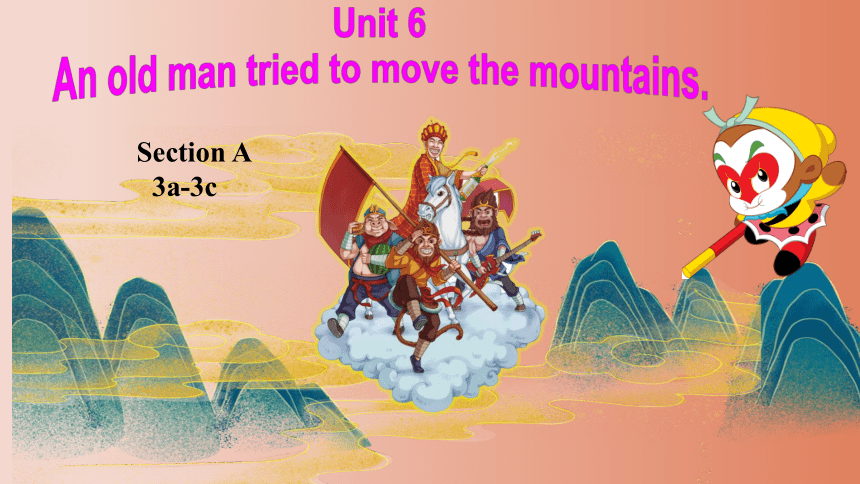 | |
| 格式 | zip | ||
| 文件大小 | 24.7MB | ||
| 资源类型 | 教案 | ||
| 版本资源 | 人教新目标(Go for it)版 | ||
| 科目 | 英语 | ||
| 更新时间 | 2023-02-28 06:31:02 | ||
图片预览

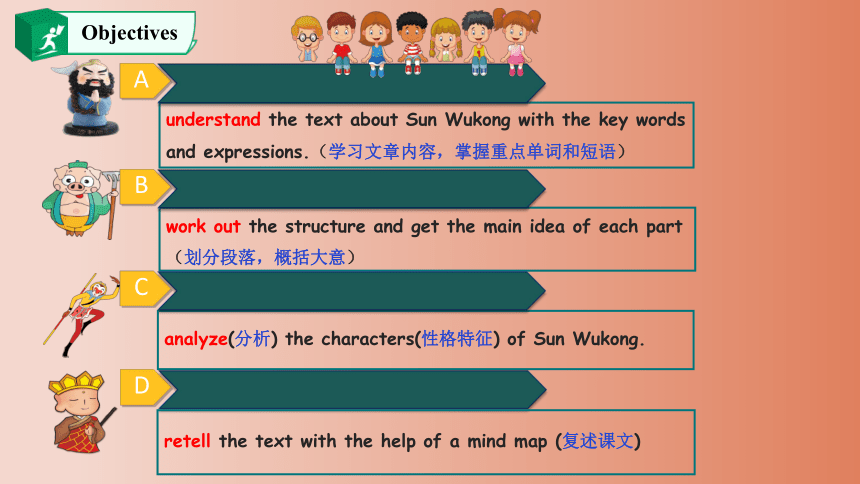
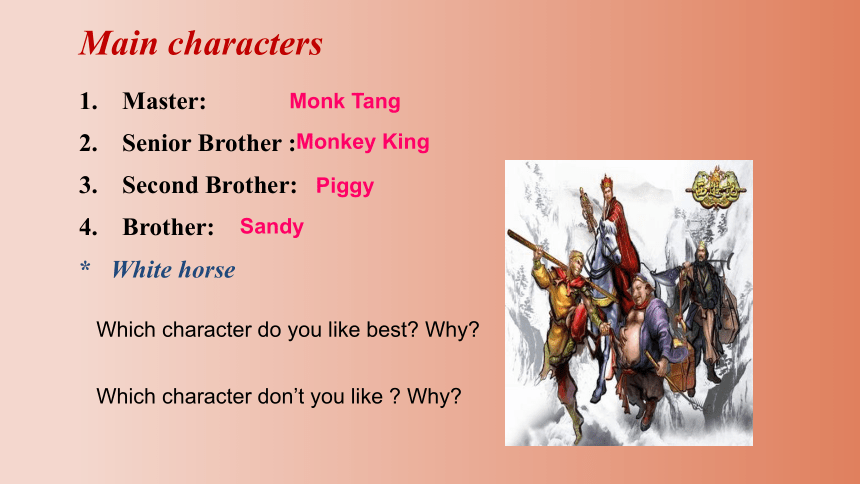
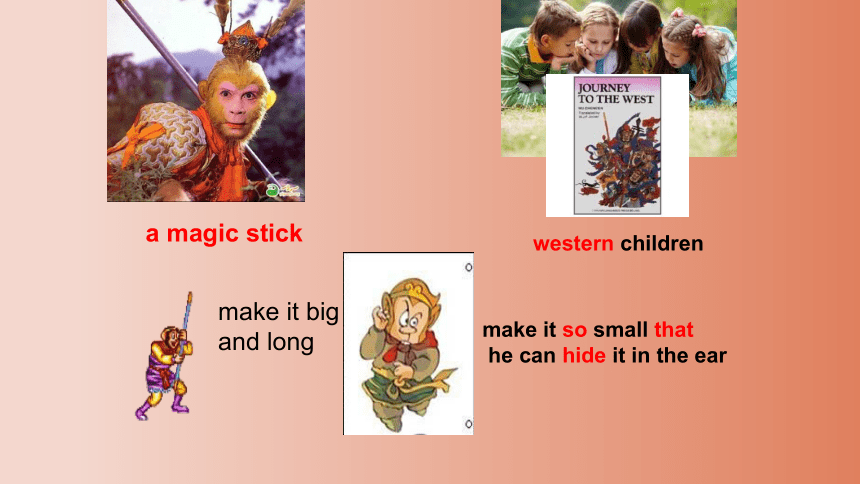
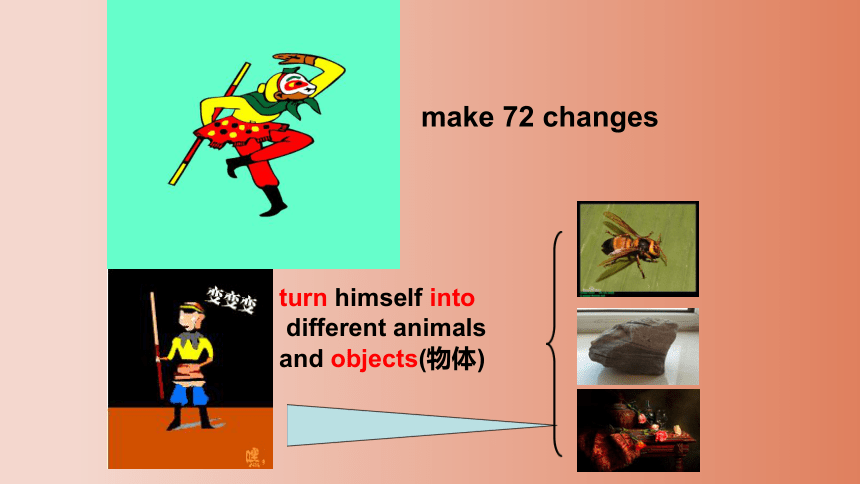
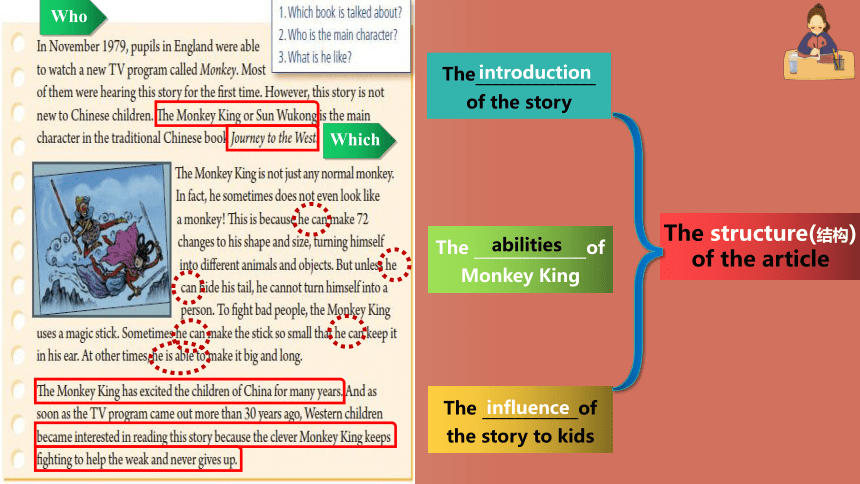

文档简介
(共17张PPT)
Section A
3a-3c
understand the text about Sun Wukong with the key words
and expressions.(学习文章内容,掌握重点单词和短语)
work out the structure and get the main idea of each part (划分段落,概括大意)
analyze(分析) the characters(性格特征) of Sun Wukong.
Objectives
A
B
C
D
retell the text with the help of a mind map (复述课文)
Main characters
Master:
Senior Brother :
Second Brother:
Brother:
* White horse
Which character do you like best Why
Which character don’t you like Why
Monk Tang
Monkey King
Piggy
Sandy
western children
a magic stick
make it so small that
he can hide it in the ear
make it big
and long
make 72 changes
turn himself into
different animals
and objects(物体)
Which
Who
The_______________ of the story
The ______________of Monkey King
The ____________of
the story to kids
The structure(结构) of the article
abilities
influence
introduction
In November 1979, pupils in England were able to watch a new TV program called Monkey. Most of them were hearing this story for the first time. However, this story is not new to Chinese children. The Monkey King or Sun Wukong is the main character in the traditional Chinese book Journey to the West.
2. Which of the following sentence is True according to Para 1
A. Pupils in America could watch the TV program Monkey in 1979.
B. All the children in England heard the story of Monkey for the first time in 1979.
C. Monkey King was new to Chinese children.
D. Monkey King is the main character in the traditional
Chinese book Journey to the West.
Paragraph 1
D
England
Most of the children
wasn’t
What is Monkey King like
he can
he can not
he can
he is able to
not normal
make the stick so small…
make it big and long
make 72 changes to…
turn himself into…
Abilities
Abilities
Paragraph 2
Paragraph 3
Why did Western children become interested in the story
Western
children
Chinese
children
The Monkey King has ______ the children of China for many years.
As soon as the TV programme came out Western children became _________ in reading this story.
Because the clever Monkey King keeps fighting to help the weak and never gives up.
popularity
知名度
spirits
精神
excited
influence
influence
interested
1
He can make 72 changes to his shape and size.
3
The clever Monkey King keeps fighting to help the weak.
2
To fight bad people, he uses a magic stick.
4
Never give up.
What do you think of the Monkey King
brave
fearless
powerful
helpful
undefeated
不服输的
Great
characters
性格特征
Let's Think!
It is Monkey King's great spirits that make people around the world love the book and keeps reading it.
As Chinese , what should we do
Miss Chen's words:
Let’s read more great traditional Chinese books!
Let’s share them with people around us!
We learn English not only to learn about foreign culture, history and custom, but to spread(传播) Chinese culture, literature to the world.
which
who
when
what
how
why
traditional Chinese
be hearing
for the first time
main character
make it …and …
make the stick so…
make 72 changes
came out
became interested in
keeps fighting to..
never gives up
hide his tail
November 1979
HELP THE MONKEY
Journey to the West
In November 1979, pupils in England knew the story of Sun Wukong because a TV program Monkey ______ out. But this story is not new to Chinese children. Journey to the West is a _________ Chinese book and the Monkey King is the main character. He _____________ make 72 _______ to his body. In this way, he _______ himself into different animals and objects. However, he cannot turn himself into a person. He uses a ______ stick to fight bad people. He can make the ______ small, big and long. Sometimes he makes it ___ small that he can keep it in his ear.
The Monkey King _______ so many children around the world. They learn that Sun Wukong _______ fighting to help the weak and never gives up.
根据课文内容和图片,补充短文。
traditional
is able to / can
changes
turns
magic
stick
excites
keeps
Monkey King
so
came
Five Finger Mountain
Why
What
Who
Summary
Which
Try to retell.
1546
步
Be brave!
Keep fighting to help the weak and never give up!
Homework
01、Try to draw a mind-map about the text.
2、Read more traditional Chinese books in holidays.
Section A
3a-3c
understand the text about Sun Wukong with the key words
and expressions.(学习文章内容,掌握重点单词和短语)
work out the structure and get the main idea of each part (划分段落,概括大意)
analyze(分析) the characters(性格特征) of Sun Wukong.
Objectives
A
B
C
D
retell the text with the help of a mind map (复述课文)
Main characters
Master:
Senior Brother :
Second Brother:
Brother:
* White horse
Which character do you like best Why
Which character don’t you like Why
Monk Tang
Monkey King
Piggy
Sandy
western children
a magic stick
make it so small that
he can hide it in the ear
make it big
and long
make 72 changes
turn himself into
different animals
and objects(物体)
Which
Who
The_______________ of the story
The ______________of Monkey King
The ____________of
the story to kids
The structure(结构) of the article
abilities
influence
introduction
In November 1979, pupils in England were able to watch a new TV program called Monkey. Most of them were hearing this story for the first time. However, this story is not new to Chinese children. The Monkey King or Sun Wukong is the main character in the traditional Chinese book Journey to the West.
2. Which of the following sentence is True according to Para 1
A. Pupils in America could watch the TV program Monkey in 1979.
B. All the children in England heard the story of Monkey for the first time in 1979.
C. Monkey King was new to Chinese children.
D. Monkey King is the main character in the traditional
Chinese book Journey to the West.
Paragraph 1
D
England
Most of the children
wasn’t
What is Monkey King like
he can
he can not
he can
he is able to
not normal
make the stick so small…
make it big and long
make 72 changes to…
turn himself into…
Abilities
Abilities
Paragraph 2
Paragraph 3
Why did Western children become interested in the story
Western
children
Chinese
children
The Monkey King has ______ the children of China for many years.
As soon as the TV programme came out Western children became _________ in reading this story.
Because the clever Monkey King keeps fighting to help the weak and never gives up.
popularity
知名度
spirits
精神
excited
influence
influence
interested
1
He can make 72 changes to his shape and size.
3
The clever Monkey King keeps fighting to help the weak.
2
To fight bad people, he uses a magic stick.
4
Never give up.
What do you think of the Monkey King
brave
fearless
powerful
helpful
undefeated
不服输的
Great
characters
性格特征
Let's Think!
It is Monkey King's great spirits that make people around the world love the book and keeps reading it.
As Chinese , what should we do
Miss Chen's words:
Let’s read more great traditional Chinese books!
Let’s share them with people around us!
We learn English not only to learn about foreign culture, history and custom, but to spread(传播) Chinese culture, literature to the world.
which
who
when
what
how
why
traditional Chinese
be hearing
for the first time
main character
make it …and …
make the stick so…
make 72 changes
came out
became interested in
keeps fighting to..
never gives up
hide his tail
November 1979
HELP THE MONKEY
Journey to the West
In November 1979, pupils in England knew the story of Sun Wukong because a TV program Monkey ______ out. But this story is not new to Chinese children. Journey to the West is a _________ Chinese book and the Monkey King is the main character. He _____________ make 72 _______ to his body. In this way, he _______ himself into different animals and objects. However, he cannot turn himself into a person. He uses a ______ stick to fight bad people. He can make the ______ small, big and long. Sometimes he makes it ___ small that he can keep it in his ear.
The Monkey King _______ so many children around the world. They learn that Sun Wukong _______ fighting to help the weak and never gives up.
根据课文内容和图片,补充短文。
traditional
is able to / can
changes
turns
magic
stick
excites
keeps
Monkey King
so
came
Five Finger Mountain
Why
What
Who
Summary
Which
Try to retell.
1546
步
Be brave!
Keep fighting to help the weak and never give up!
Homework
01、Try to draw a mind-map about the text.
2、Read more traditional Chinese books in holidays.
同课章节目录
- Unit 1 What's the matter?
- Section A
- Section B
- Unit 2 I'll help to clean up the city parks.
- Section A
- Section B
- Unit 3 Could you please clean your room?
- Section A
- Section B
- Unit 4 Why don't you talk to your parents?
- Section A
- Section B
- Unit 5 What were you doing when the rainstorm came
- Section A
- Section B
- Review of Units 1-5
- Unit 6 An old man tried to move the mountains.
- Section A
- Section B
- Unit 7 What's the highest mountain in the world?
- Section A
- Section B
- Unit 8 Have you read Treasure Island yet?
- Section A
- Section B
- Unit 9 Have you ever been to a museum?
- Section A
- Section B
- Unit 10 I've had this bike for three years.
- Section A
- Section B
